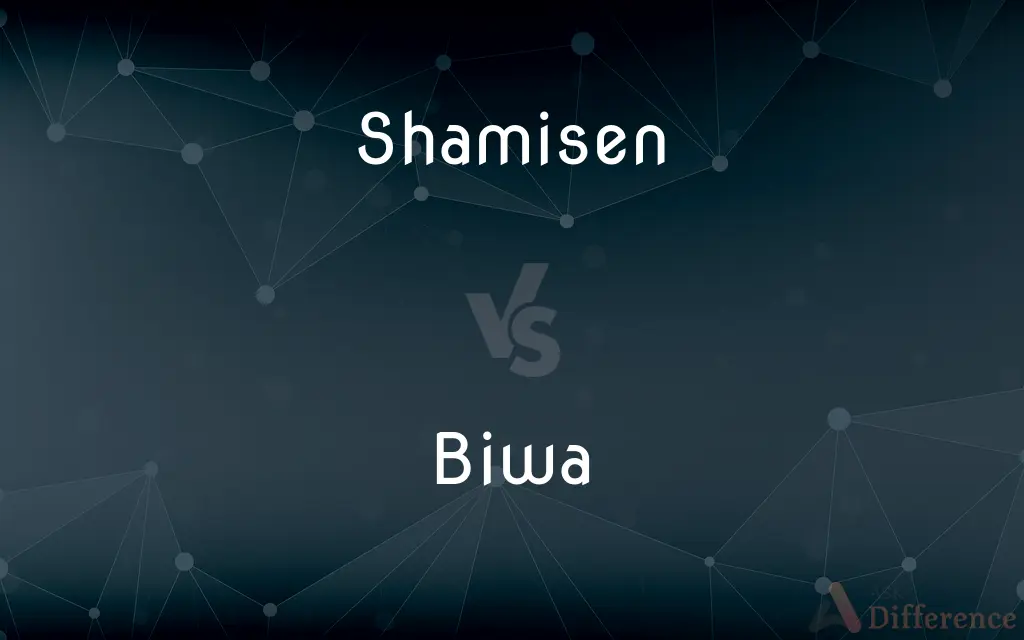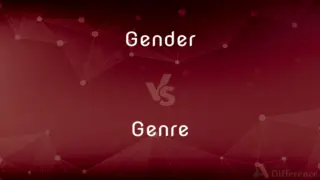Shamisen vs. Biwa — What's the Difference?
By Tayyaba Rehman — Updated on November 3, 2023
The shamisen is a three-stringed Japanese lute, while the biwa is a Japanese short-necked fretted lute, often used in narrative storytelling.

Difference Between Shamisen and Biwa
Table of Contents
ADVERTISEMENT
Key Differences
The shamisen, with a slender neck and no frets, produces a distinct twangy sound, unlike the biwa's deeper tone. Both the shamisen and the biwa have a pear-shaped body, but the shamisen's is smaller and covered with skin, whereas the biwa's is larger and wooden.
Shamisen players pluck the strings with a large plectrum called a bachi, which is also used in playing the biwa, though the biwa's bachi is often larger and more triangular.
The shamisen is associated with several Japanese music genres, such as kabuki and bunraku, and the biwa is often linked to traditional narratives, like the Tale of the Heike.
Both instruments are integral to Japan’s musical culture, but the shamisen has gained more international recognition compared to the biwa.
Comparison Chart
Number of Strings
Three
Four to five
ADVERTISEMENT
Body Shape
Smaller, skin-covered
Larger, wooden
Sound
Twangy, sharper
Deeper, resonant
Frets
None
Fretted
Cultural Association
Kabuki, Bunraku
Narrative storytelling, The Tale of the Heike
Compare with Definitions
Shamisen
Three-stringed lute played with a bachi
She practiced the shamisen for hours.
Biwa
Fretted instrument with a pear-shaped body
He was a master of the biwa, enchanting audiences.
Shamisen
Lute with a distinct, twangy sound
The sound of the shamisen is unmistakable.
Biwa
Often used to accompany epic narratives
Narrators of ancient tales used the biwa as their accompaniment.
Shamisen
Integral to Japanese folk music
Folk tales often feature the shamisen.
Biwa
Instrument with four to five strings
The biwa has more strings than a shamisen.
Shamisen
A traditional Japanese stringed instrument
The melody of the shamisen wafted through the festival.
Biwa
Associated with traditional Japanese culture
The biwa is deeply rooted in Japan’s cultural heritage.
Shamisen
Instrument used in kabuki theatre
A shamisen player accompanied the actors.
Biwa
A Japanese lute used in classical music
The biwa's resonant tones filled the concert hall.
Shamisen
The shamisen (三味線), also known as the sangen (三絃) or samisen (all meaning "three strings"), is a three-stringed traditional Japanese musical instrument derived from the Chinese instrument sanxian. It is played with a plectrum called a bachi.
Biwa
The biwa (Japanese: 琵琶) is a Japanese short-necked wooden lute traditionally used in narrative storytelling. The biwa is a plucked string instrument that first gained popularity in China before spreading throughout East Asia, eventually reaching Japan sometime during the Nara period (710-794).
Shamisen
A Japanese musical instrument resembling a lute, having a very long neck and three strings played with a plectrum.
Biwa
A plucked lute, originating in the classical and traditional music of Japan, characterized by a pear-shaped body and four or five high frets, giving the instrument a distinctively twangy tone.
Shamisen
(musical instrument) A kind of three-stringed Japanese fretless lute.
Shamisen
A Japanese stringed instrument resembling a banjo with a long neck and three strings and a fretted fingerboard and a rectangular soundbox; played with a plectrum
Common Curiosities
How is the sound of a shamisen distinctive?
The shamisen has a sharp, twangy sound due to its taut, skin-covered body and three strings.
What is a biwa?
A biwa is a Japanese lute with four to five strings, used in traditional music and storytelling.
What kind of music is the biwa associated with?
The biwa is often associated with narrative storytelling, particularly the epic "The Tale of the Heike."
Are shamisen strings made from silk?
Traditional shamisen strings were made from silk, but modern ones can be made from nylon or other materials.
Can a beginner learn the shamisen?
Yes, beginners can learn the shamisen, but it requires practice to master its unique playing techniques.
Is the shamisen played solo or in ensembles?
The shamisen can be played both as a solo instrument and in ensembles.
Are there different types of shamisen?
Yes, there are several types of shamisen, varying in size and associated with different musical genres.
Is it difficult to maintain a biwa?
The biwa requires regular maintenance, such as tuning and taking care of its wooden body.
What is a shamisen?
A shamisen is a three-stringed Japanese instrument, traditionally played with a plectrum called a bachi.
Is the biwa fretted?
Yes, the biwa has frets along its neck which allow for a variety of pitches.
Do shamisen and biwa music require vocal accompaniment?
Both instruments can be accompanied by vocals but are also played instrumentally.
What is the biwa's role in Japanese culture?
The biwa holds a significant role in Japanese culture as a bearer of history and storytelling.
What is the main playing technique for the biwa?
The biwa is played with a plectrum, striking or plucking the strings and using the frets for melodic expression.
How is the bachi for the biwa different from the shamisen's?
The biwa's bachi is often larger and has a more triangular shape compared to the shamisen's bachi.
How has the shamisen's popularity evolved?
The shamisen has become more internationally recognized, often featured in fusion and contemporary music genres.
Share Your Discovery

Previous Comparison
Demanding vs. Challenging
Next Comparison
Gender vs. GenreAuthor Spotlight
Written by
Tayyaba RehmanTayyaba Rehman is a distinguished writer, currently serving as a primary contributor to askdifference.com. As a researcher in semantics and etymology, Tayyaba's passion for the complexity of languages and their distinctions has found a perfect home on the platform. Tayyaba delves into the intricacies of language, distinguishing between commonly confused words and phrases, thereby providing clarity for readers worldwide.
















































